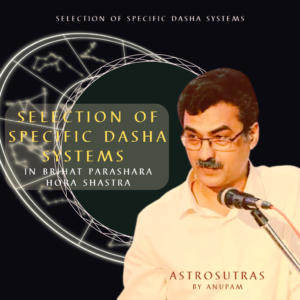Dasha Bhed (Types of Dasha) in Brihat Parashara Hora Shastra
The Brihat Parashara Hora Shastra (BPHS) is one of the most authoritative texts on Vedic astrology, attributed to Sage Parashara. Among its many profound teachings, BPHS discusses different types of planetary periods (Dasha systems), which play a crucial role in predicting the timing of events in a person’s life. The concept of Dasha Bhed refers to the various methods of calculating planetary periods, each suited for different circumstances and horoscopic considerations.
Significance of Dasha Systems
The Dasha system is a unique contribution of Vedic astrology, providing a structured way to determine the unfolding of karmic influences over time. Unlike Western astrology, which relies heavily on transits, Vedic astrology gives prominence to planetary periods to decode the sequence of life events. Different Dasha systems exist, each with distinct applications depending on the nature of the horoscope.
Types of Dasha Mentioned in BPHS (Dasha Bhed)
BPHS primarily focuses on Vimshottari Dasha, but it also mentions several other Dasha systems, which are broadly classified into three categories:
- Nakshatra-Based Dashas (Udu Dasha)
- These are based on the placement of the Moon in a particular Nakshatra at the time of birth.
- The most well-known and widely used system under this category is Vimshottari Dasha.
- Other types include:
- Ashtottari Dasha (108 years cycle)
- Shodashottari Dasha (116 years cycle)
- Dwadashottari Dasha (112 years cycle)
- Panchottari Dasha (105 years cycle)
- Shatabdika Dasha (100 years cycle)
- Chaturashiti Dasha (84 years cycle)
- These systems are used for specific birth conditions and planetary placements.
- Rashi-Based Dashas (Graha Dasha or Rashi Dasha)
- These Dashas are based on the signs (Rashi) occupied by planets and are often used in conjunction with Nakshatra-based Dashas.
- Some important ones include:
- Chara Dasha (primarily used in Jaimini astrology)
- Sthira Dasha
- Yogini Dasha (associated with tantric and mystical influences)
- Drig Dasha (based on planetary aspects)
- Other Special Dashas
- These are conditional Dashas applied in specific cases where traditional systems may not be effective.
- Examples include:
- Kala Chakra Dasha (based on the movement of the Zodiac Wheel)
- Sudasa Dasha (used for deeper karmic analysis)
- Mandook Dasha (applied for rapid life changes)
- Pindayu Dasha (lifespan-based system)
Vimshottari Dasha: The Most Prominent Dasha System
BPHS places the greatest emphasis on Vimshottari Dasha, which is considered the most reliable and universally applicable system. It follows a 120-year cycle, allocating different periods to each planet based on their Nakshatra lordship.
The sequence of Vimshottari Dasha is:
- Ketu – 7 years
- Venus – 20 years
- Sun – 6 years
- Moon – 10 years
- Mars – 7 years
- Rahu – 18 years
- Jupiter – 16 years
- Saturn – 19 years
- Mercury – 17 years
The starting point of the Dasha is determined by the Moon’s Nakshatra at birth, and this system governs life events in a precise, time-bound manner.
Choosing the Right Dasha System
While Vimshottari Dasha is the default for most charts, other systems are used in special cases:
- Ashtottari Dasha is used when Rahu is in a Kendra (angle) or Trikona (trine).
- Chara Dasha is applied in Jaimini astrology for life direction analysis.
- Yogini Dasha is used for mystical and occult influences.
- Kala Chakra Dasha is applied for spiritual evolution and destiny mapping.
Conclusion
The Dasha Bhed as outlined in Brihat Parashara Hora Shastra provides deep insights into the progression of life events. Understanding and applying the right Dasha system is crucial for accurate predictions in Vedic astrology. Among the many systems, Vimshottari Dasha remains the most widely practiced due to its universal applicability. However, advanced astrologers often use multiple Dashas for a comprehensive analysis of a horoscope.
